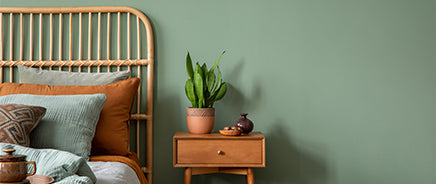
HOW TO CHOOSE A PAINT COLOR
There’s more to finding the perfect color than a punny name—hello, Mauve-a-Lish! The more you know about your project and some color theory basics the easier it will be to find the perfect color.
PROJECT SCOPE
Get to know your space, like really. Take a moment and sit in your space to look it over from top down and write down your project scope. Ask yourself the following questions: Do I need to repaint my ceiling? What kind and how much light do I have in the space? What color are my existing walls? What gloss are they? What about the color do I not like? What kind and what color are my floors? Are there cabinets, countertops, built-ins, etc. in the space that I need to consider? What about window coverings? Now consider your furniture, art, décor, and lines. Taking a catalog of your space will help you be more decisive in your color selection process.
Every paid Color Session starts with a Project Questionnare that helps you develop your Project Scope. This helps our Color Influencers better understand your project details.

PROJECT GOALS
Every painting project begins with a big idea. Maybe it’s brightening up a dark space, injecting a little glam into your world, or even undoing the color madness the previous tenant thought was good idea. Whatever the project, you have a goal in mind. That goal will not only steer you toward—or away—from certain colors, it will also give shape to your plan of action for tackling the project.
As you consider all the possibilities, be both thoughtful and realistic. Be open and willing to revise your big idea to make it work within the realities and potential of your situation. Once you’ve determined how you’re going to bring your big idea to life, you can build a to-do list that puts what you need to do in sequential order. From there, you’ll want to drill down deeper and create a detailed game plan that breaks the tasks into required materials, tools and time. While this may sound tedious, especially to right-brain DIYers, having a fine-tuned game plan will actually help keep your project on track and ensure that all the decisions you make, be it color or what to do next, help bring your big idea to life.
You’ve taken the time to get a detailed project scope and planned out your goals. Now you need a vision for your space. Check out our Pinterest for some colorful ideas.

COLOR VOCABULARY
As with all communication, conversations about color go better when every one is speaking the same language. Let's learn some of the most essential color terms to use when talking color.

IMPORTANT COLOR TERMS
• Hues describe a pure color that is found on the color wheel and has had nothing added to it to change its properties.
• Tints are created when a hint of color is added to a white base, resulting in a desaturate hue.
• Tones are created when gray is added to a color. The final tone depends on the amount of black and white used, and tones may be lighter or darker than the original hue.
• Shades are created when black is added to any hue found on the color wheel. This process darkens the hue and creates a more intense color.
UNDERSTANDING ICONS
• Alkali-sensitive colors are those that are more likely to fade early when used on high-alkaline surfaces, such as new masonry. New concrete and stucco should cure (aka dry) for at least 30 days before applying these colors.
• Historical colors are those that are historically accurate.
• Interior-only colors are those with a low resistance to the sun's UV rays, causing them to fade. These are typically bright or bold colors not used outdoors.
• Low-hide colors are those that are more transparent, thus may require more than two coats for best coverage, which requires more paint and more time to apply.

COLOR WHEEL
A visual representation of colors, the color wheel presents hues arranged according to wavelength and their chromatic relationship to one another.
The three overarching types of color are:
• Primary colors (red, yellow and blue) are the colors from which all other colors are created.
• Secondary colors (orange, green and violet) are created by mixing primary colors. The particular color of the secondary color you get will depend on which red, blue or yellow you use and how much you mix in them.
• Intermediate colors (red-orange, orange-yellow, yellow-green, green-blue, blue-violet and violet-red) are achieved by mixing two secondary colors. Color can be used in different schemes or in combination to achieve different effects.

COLOR SCHEMES
Here's a quick look at a few of the most common schemes:
• Monochromatic schemes use different shades and tints of a single color to create a harmonious, visually cohesive look. But be sure to have enough contast. This is the most common scheme.
• Complementary schemes draw from colors found directly opposite each other on the color wheel (purple and green or orange and blue). Because they're opposites, they create a lot of visual interest. Utilize tints, tones and shades to create depth and make it feel more sophisticated.
• Analogous schemes use colors that are next to each other on the color wheel (primary, secondary and intermediate). Together, they create a serene, calming palette. Just because an analogous scheme uses three colors, that does not mean you must paint with all three colors. Utilize the accents in the space to tie together the Analogous scheme.
It can lift your mood, motivate you to take action, and even suppress appetite. The right (or wrong) color combinations take that power to a whole new level, which is why it's important to have a basic understanding of how color works.

Pick your color
Color says a lot without saying a word. Given the different energy and moods color can create, it's important to choose the right ones for the space you're looking to create or transform. Here's a look at what different colors communicate.




































